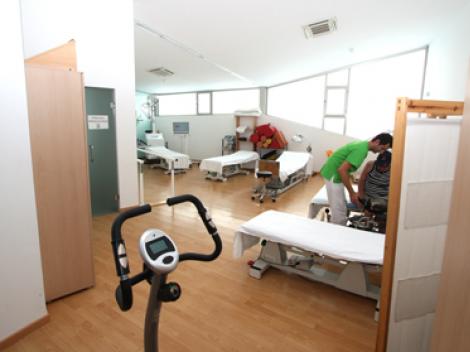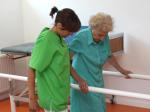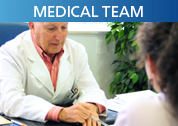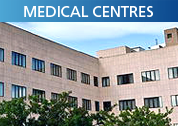


Hip
Information about hip rehabilitation
Hip rehabilitation starts after the patient is discharged from the clinic or hospital where he/she had their operation.
During the post-operative hip rehabilitation period it is important to do rehabilitation exercises in which full and gradual rehabilitation depends largely on the patient's persistence and continuity with the exercise programme.
Hip Rehabilitation treatment
- A drainage massage is administered and the patient is shown how to place the affected limb.
- Active and assisted mobilisation are applied to the articulations of the affected lower limb.
- The patient is shown how to do static isometric exercises for the muscle groups around the hip and buttocks area - psoas iliacus - adductors and pelvic muscles plus core muscles in the trunk.
- Electro-analgesic treatment is applied. Ultrasound - anti-inflammatory drugs - tissue repair metabolism activators. Thermotherapy - Cryotherapy. (Measures intended to improve the articulation and muscle tone around the hip prosthesis).
- Assisted mobilisation of the hip is done manually at first, gradually increasing the degree of flexion and extension of the replacement hip joint.
- Muscular electro-stimulation may be applied to muscle groups that have been weakened following the operation, with special easy-to-use electrical stimulators.
- Special emphasis is placed on preventing flexion in the replaced hip by showing the patient how to do exercises in a prone position and also be applying weight on the operated hip while the patient is a prone position.
- Showing patients how to move from the trolley, to a chair and into bed Restoring patients' confidence when moving their lower limbs.
- Patients are shown how to stand correctly, with support for the leg on the affected side, spreading their weight, and they are also shown how to do load-bearing exercises This is usually done facing a mirror so the patient can improve control over their posture when standing upright.
- Patients are given exercises to tone the pelvis and trunk to make standing upright easier and give them increased body control before starting walking exercises.
- Walking exercises using parallel bars, assisted walking using crutches, walking up and down ramps and stairs.
- Exercises to improve proprioception in lower limbs Practising changing direction, avoiding obstacles, changing surfaces.
- If the operation wound has healed and the patient is given the go-ahead to use the pool: Aqua-walking in the hydrotherapy pool to build strength and confidence for walking independently without walking aids.
- Patients are given guidance on how to look after their hip replacement and prevent undesired complications They are normally advised not to sit cross-legged, open their hips sideways or sit on low chairs.
- Patients are also given advice from the occupational therapists on adapting their bathroom and toilet fitting to make them easier to use.
Maintenance and Practical Advice
- Take frequent short walks, this is excellent exercise, but avoid irregular surfaces and hills.
- Replacement hips require more care as they are not as perfect as a normal hip.
- Be careful during the first 6-12 weeks after your hip operation to prevent problems arising in the joint.
- You will be given a series of practical tips and guidance for carrying out your everyday activities.
The importance of immediate rehabilitation
- Thorough rehabilitation is essential following an operation of this kind. Hip Rehabilitation should start as soon as possible and patients should try to avoid travelling, making sudden movements or lifting heavy objects in the first few days. Before patients return to their home country, we advise them to undertake at least 8 days of rehabilitation at our Casaverde rehabilitation centre.
- An early start enables muscle tone to be improved; muscles around the affected area become gradually stronger and more powerful as they are worked consistently during treatment. Strong muscles reduce the risk of falls and complications.
- Early rehabilitation leads to a faster recovery of movement in the affected joint and reduces the pain and/or soreness that may develop following an operation.
- Early rehabilitation improves trophism (nourishment of the tissues surrounding the surgery site) and encourages the wound to heal correctly.
- Rehabilitation enables mobility to be recovered faster, enabling patients to walk again with the assistance and guidance of the care team as they learn to re-programme their walking patterns.



